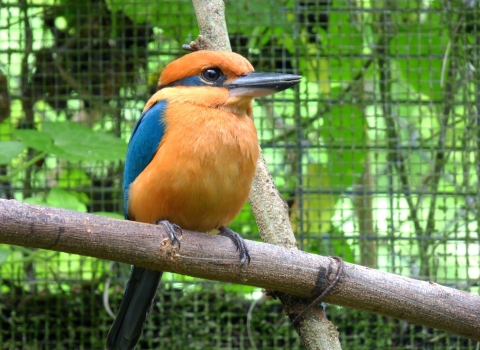Six sihek (Guam kingfisher) are now officially living in the wild, in the tropical forests of Palmyra Atoll. This release marks the first time since the 1980s these beautiful birds will reside in the wild.
Great hopes rest on the wings of these sihek. They are the result of years of work by the Sihek Recovery Program, a global collaborative of conservationists dedicated to reestablishing the sihek in the wild for return to its homeland in Guam. The Program includes partners from the: U.S. Fish & Wildlife Service (USFWS), Guam Department of Agriculture’s Division of Aquatic & Wildlife Resources (DOAG), ZSL, The Nature Conservancy (TNC), Sedgwick County Zoo, Association of Zoos and Aquariums (AZA), and the International Union for the Conservation of Nature (IUCN). These partners are globally recognized leaders in animal care, conservation translocation, ecological restoration and wild population management and have applied their expertise to recover several other extinct in the wild species.
A total of nine young birds —four female and five male sihek — were hand-reared over the last several months at the Sedgwick County Zoo for this historic rewilding. AZA partners contributing eggs or young chicks to this effort include the Brookfield Zoo, Cincinnati Zoo & Botanical Garden, Disney’s Animal Kingdom (Disney’s Animals, Science, and Environment), National Aviary, and Sedgwick County Zoo. Smithsonian’s National Zoo and Conservation Biology Institute (NZCBI) coordinated egg selection and transfer, and managed the care of the birds along with ZSL staff. The sihek made their maiden voyage from Wichita, Kansas to temporary aviaries on The Nature Conservancy preserve and research station at Cooper Island on August 28, 2024. Specialists have been caring for the palm-sized birds, ensuring that the sihek safely settled into their aviaries, acclimatized to their new homes, and received daily feedings.
“We are demonstrating that passion and partnership can make amazing things happen,” said Megan Laut, U.S. Fish and Wildlife Service recovery program manager. “The diverse skill set and contributions of each partner have led us to this historic milestone and will inform our efforts to grow the global population of sihek and take meaningful advances to return sihek to Guam.”
The birds have displayed very promising behavior such as eating right away, instinctually preening when they experienced their first rainfall and successfully hunting the spiders, geckos and crabs they will rely on for food.
Prior to release from the aviaries, each sihek was given a health exam. A tiny radio tracker was fitted to each bird before release so the project team can monitor their movements as they settle into new habitat at locations across the atoll. Sihek are a territorial species, and the team expects the birds will establish home ranges quickly, which will also help with locating and monitoring them with a special focus on habitat use, foraging, and eventual breeding. Supplemental food will also be available to help them transition to the wild.
First listed under the Guam Endangered Species Act in 1982, the sihek was subsequently added to the U.S. Endangered Species List in 1984. Endemic to the forests of Guam and culturally important to the CHamoru* people, the sihek have been extinct in the wild since 1988 due to predation by the invasive, brown tree snake. The Guam DOAG and AZA rescued 29 sihek and established a captive-care program, which currently is composed of 127 adult sihek across 25 institutions, nationwide.
Palmyra Atoll was selected as the inaugural site for sihek to be released to the wild because it is invasive predator-free and fully protected. Palmyra Atoll is a U.S. Fish and Wildlife Service National Wildlife Refuge and is further protected—out to 50 nautical miles—by the Pacific Remote Islands Marine National Monument, one of the largest swaths of ocean and islands protected under a single jurisdiction in the world. The Nature Conservancy manages a preserve and research station at Palmyra on Cooper Island. These facilities enable globally significant ocean, coral reef and island research and restoration such as this sihek project. The atoll will provide the sihek a safe, wild home to thrive in and establish a breeding population, with the ultimate goal of one day returning the species to Guam once the threat from snakes is addressed.
“Palmyra provides a welcoming environment for the sihek and one that is conducive for monitoring their transition from human care to life in the wild,” said, Stefan Kropidlowski, Pacific Remote Islands Marine National Monument Deputy Superintendent at US Fish and Wildlife Service. “This is a historic milestone and a vital step for project managers as we learn from the sihek as they are actively adapting and exploring their new habitat.”
At this time, six of the nine sihek were deemed ready for release. The remaining three sihek will be released individually as each bird reaches milestones needed to survive in the wild. This approach provides necessary flexibility, as some birds may require more time to prepare for life in the wild. Sihek Recovery Program partners plan to continue supplementing the population annually, with a target of establishing 10 sihek breeding pairs.
This introduction of sihek to Palmyra will allow Sihek Recovery Program partners time to monitor and learn how sihek respond to returning to the wild. This initial release of sihek will help refine and tailor future releases and monitoring techniques, and provide an important step toward the goal of returning sihek to their native home on Guam.




